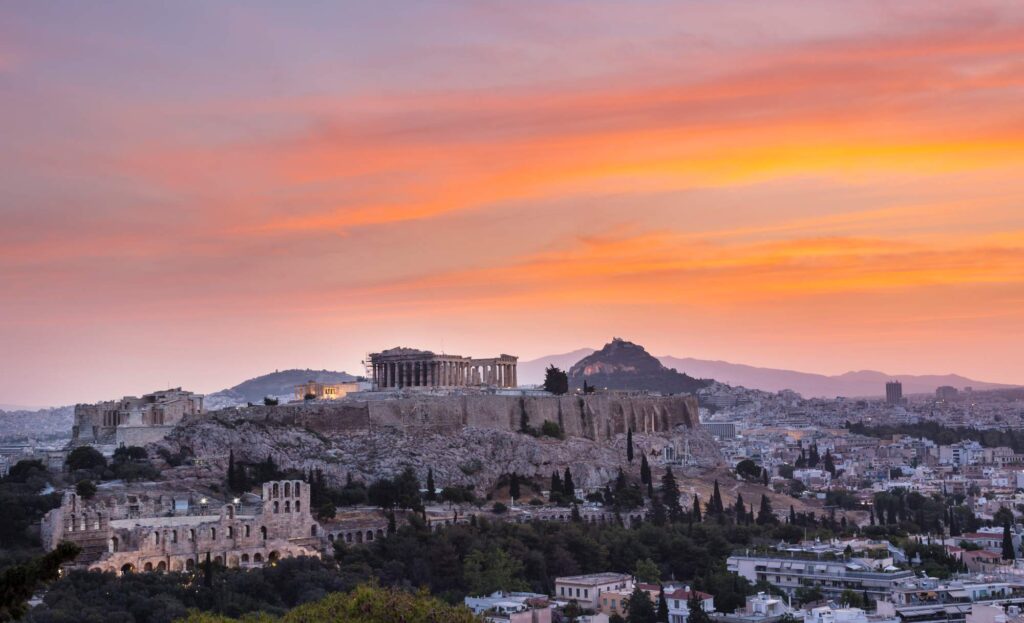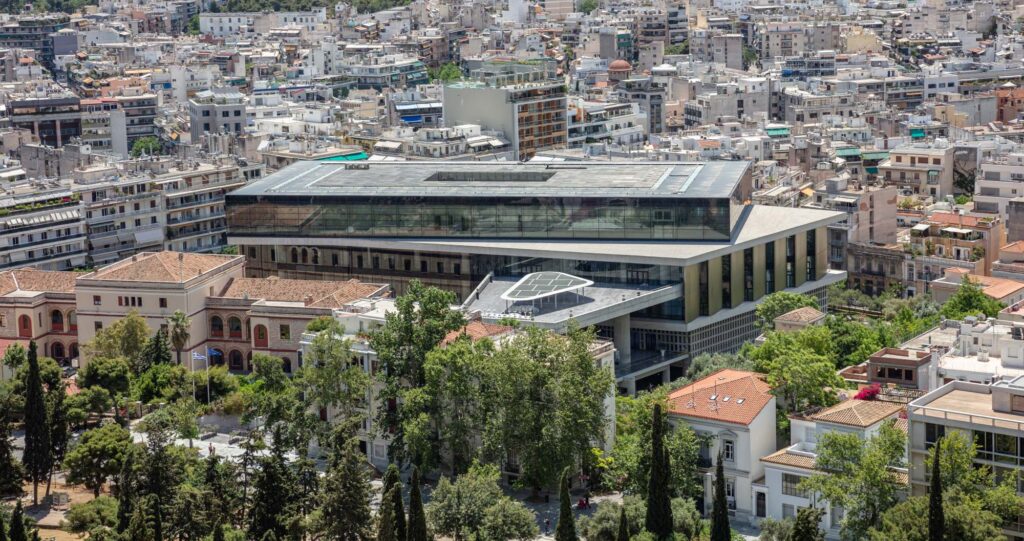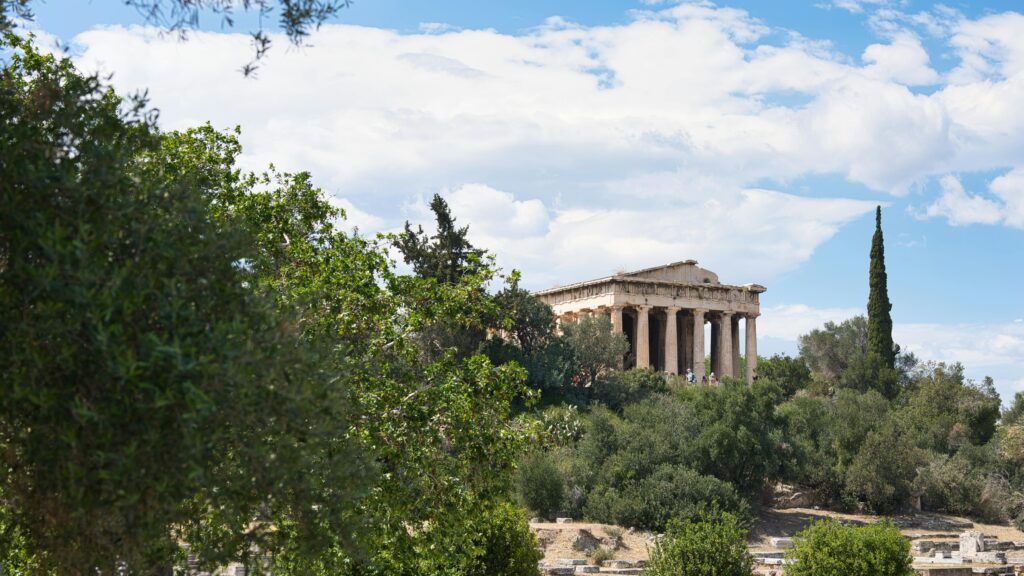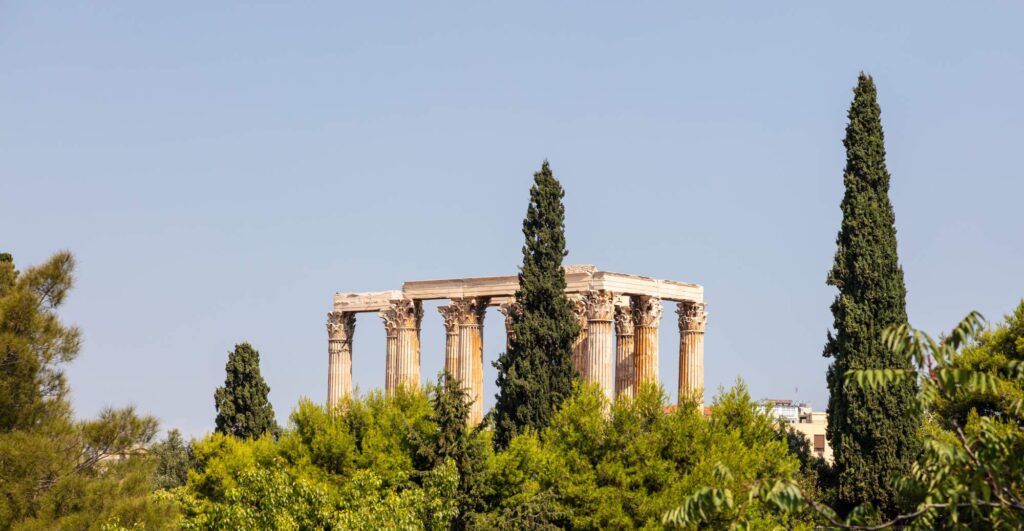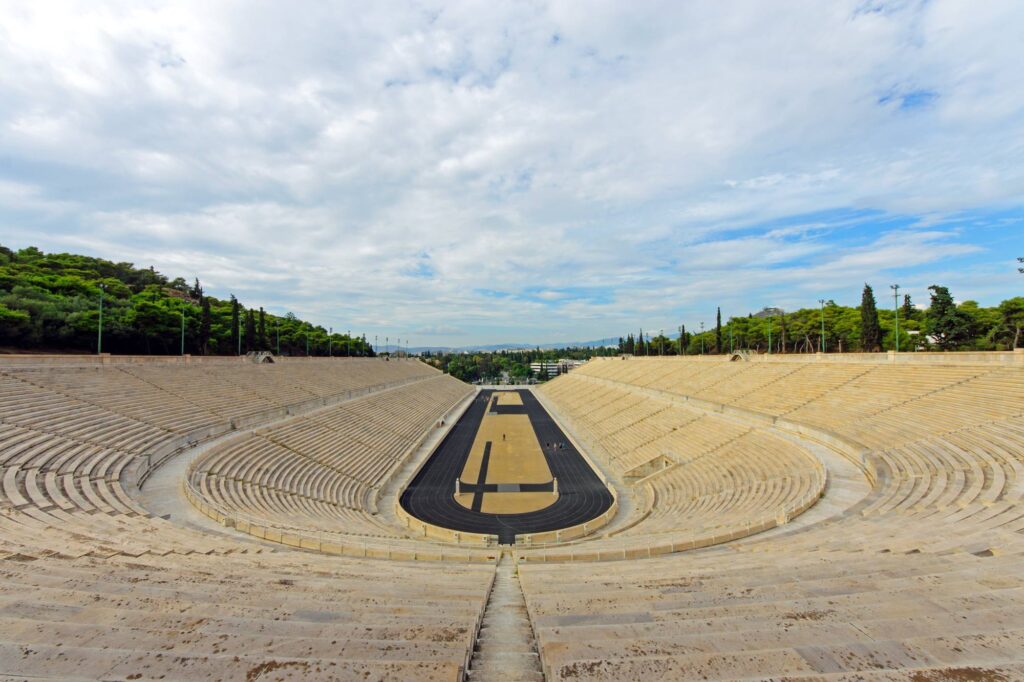Nestled between the historic ruins and vibrant modernity, Athens stands as a city where the past and present beautifully intertwine. As you fly over the Attican peninsula, the sight of Athens’ hilly landscape, sprawling olive groves, and palm tree-lined avenues paints a picture of timeless beauty. Yet, upon landing, the city reveals its unique character—an energetic urban hub that diverges from the serene, slow-paced countryside often associated with Greece.
Athens, with its rich tapestry of history, culture, and contemporary life, offers a plethora of attractions and activities. From the ancient Acropolis and bustling neighborhoods to hidden gems and panoramic views, the city has something for every traveler. Navigating through its diverse offerings can be overwhelming, especially with a population exceeding three million and countless sights to explore.
To help you make the most of your visit, we’ve curated a list of the top 10 must-see sights in Athens. This guide will take you through both iconic landmarks and lesser-known treasures, ensuring you experience the essence of this remarkable city. Whether you’re here for a day or an extended stay, these sights will leave you captivated by Athens’ timeless charm.
Here are the top sights in Athens:
1. Visit Acropolis Hill: Athens' Timeless Epicenter
Although Athens boasts several historically significant hills, none is as renowned or iconic as the Acropolis—the “high city” that has stood as a testament to Greece's rich heritage for millennia. This limestone rock formation is more than just a citadel; it has been a pivotal religious site and the heart of the famed Periclean building program since antiquity.
During Greece’s classical era, this ambitious program saw the construction of magnificent temples made from Pentelic marble, dedicated to various ancient Greek deities. The most prominent of these is the Parthenon, a temple associated with Athena, the city’s patroness. Alongside it stand other significant structures, such as the Erechtheion, the Sanctuary of Zeus Polieus, and the Temple of Athena Nike, each contributing to the Acropolis's grandeur.
Today, the Acropolis Hill remains one of Greece’s most visited archaeological sites. While it no longer serves as an active religious center, it symbolizes the Classical Era’s glory. As the Parthenon rises majestically, it underscores Athens' status as the “cradle of Western civilization” and a universal emblem of Western ideals and values.
Situated in the heart of the city, reaching the Acropolis Hill is a straightforward journey. Visitors can follow the iconic Dionysiou Areopagitou Street, conveniently located near the Acropolis Museum and the Acropolis metro station. Entry to the site is free for children under five and young European citizens, while regular tickets are priced around 20€, varying with the season. On certain Sundays and selected dates, all visitors can enjoy free access to this historic marvel.
Visiting the Acropolis
A visit to the Acropolis is an essential experience for anyone exploring Athens. Rising 156 meters above the city, this hill offers breathtaking views and is visible from most neighborhoods. The top of the Acropolis is home to the famous Parthenon, dedicated to the goddess Athena, as well as the temples of Erechtheion and Athena Nike, among other historic sites.
Travelers often say that the hike to the Acropolis is as memorable as the monuments themselves. It is recommended to begin the trek in the early morning or late afternoon to avoid peak temperatures and crowds. For those seeking the perfect photo opportunity, arriving just before sunset offers the best lighting and views.
Visitors with mobility issues can use an elevator to access the Acropolis; however, navigating the site can still be challenging due to its gravel pathways and lack of ramps. It's advisable to allow extra time when visiting with a wheelchair.
Whether you're a history enthusiast or simply a traveler in search of stunning vistas, the Acropolis Hill promises an unforgettable experience, steeped in the rich legacy of ancient Greece.
2. The Acropolis Museum: A Journey Through History
The Acropolis Museum is more than just a repository of ancient artifacts; it is a modern marvel that bridges the past and the present, offering an immersive experience into the history of one of the world's most iconic archaeological sites.
Historical Background
The need for a new museum arose in the late 20th century, as the old Acropolis Museum, located on the Acropolis Hill itself, became insufficient to house the growing collection of artifacts and accommodate the increasing number of visitors. The construction of the new Acropolis Museum was a significant undertaking, reflecting Greece's commitment to preserving its cultural heritage while providing a state-of-the-art facility for education and tourism.
Design and Construction
The museum was designed by Swiss-born American architect Bernard Tschumi in collaboration with Greek architect Michalis Photiadis. The design is notable for its modernist approach, featuring glass and concrete elements that create a harmonious blend with the ancient artifacts it houses. Construction began in 2003 and the museum opened its doors to the public in June 2009.
One of the most innovative aspects of the museum's design is its transparency. Extensive use of glass allows natural light to flood the interior, enhancing the viewing experience and creating a visual
connection with the Acropolis. This transparency also includes the glass floors that reveal ongoing excavations below, allowing visitors to witness the layers of history beneath their feet.
Collections and Exhibits
The museum’s collection is meticulously organized to provide a chronological journey through ancient Greek history. The layout is designed to mirror the ascent to the Acropolis itself, starting from the ground floor and culminating on the top floor with the Parthenon Gallery.
Ground Floor
- Archaeological Excavations: Visitors start their tour with a view of the excavation site beneath the museum, visible through the glass floors.
- Archaic Gallery: Showcases artifacts from the Archaic period (7th century BC to early 5th century BC), including early statues, votive offerings, and everyday objects.
First Floor
- Caryatid Statues: The magnificent statues from the Erechtheion temple, displayed in a way that highlights their beauty and significance.
- Classical Period Sculptures: Includes significant works from the Classical period, reflecting the artistic achievements of the time.
Top Floor
- Parthenon Gallery: The highlight of the museum, this gallery houses the Parthenon friezes, metopes, and pediments, arranged to reflect their original placement on the temple. The surrounding glass walls offer panoramic views of the Acropolis, creating a direct visual link to the Parthenon itself.
Importance and Impact
The Acropolis Museum not only serves as a repository for invaluable artifacts but also plays a crucial role in the preservation and interpretation of ancient Greek culture. It is a center for research, conservation, and education, attracting scholars and visitors from around the world. The museum has also been a focal point in the ongoing debate over the repatriation of the Parthenon Marbles, advocating for their return from the British Museum to their original context in Athens.
Visiting Information
Located in the Makrigianni district, just below the Acropolis, the museum is easily accessible and offers various amenities, including a café with a view of the Acropolis, a gift shop, and multimedia guides to enhance the visitor experience. The Athens City Pass provides a convenient and cost-effective way to explore the museum and other key archaeological sites in Athens.
The Acropolis Museum stands as a testament to Greece’s dedication to preserving its rich cultural heritage. It offers visitors a unique and immersive experience, allowing them to explore the ancient world through a modern lens. Whether you are an avid history enthusiast or a casual traveler, the Acropolis Museum is an essential stop on any visit to Athens, providing a deeper understanding of the city’s glorious past and its enduring legacy.
Click here to get tickets and pricing to the Acropolis Museum and Guided Audio Tour.
3. The Ancient Agora of Athens: The Heart of Classical Civilization
The Ancient Agora of Athens, located northwest of the Acropolis, is one of the most significant and vibrant archaeological sites in Greece. This ancient marketplace was much more than a hub of commerce; it was the focal point of political, social, and cultural life in Athens.
Historical Significance
The Agora served as the center of Athenian public life. It was the place where citizens gathered to discuss politics, philosophy, and daily affairs. It was here that many of the great ideas that shaped Western civilization were born. Prominent figures such as Socrates, Phidias, Alcamenes, and Praxiteles frequented the Agora, contributing to its reputation as a cradle of intellectual and artistic activity.
Key Landmarks
Visitors to the Ancient Agora can explore several well-preserved structures and ruins that offer a glimpse into ancient Athenian life:
- Temple of Hephaestus: This remarkably intact temple, dedicated to the god of craftsmanship and metalworking, Hephaestus, stands on a hill overlooking the Agora. It was used as a church during the Byzantine era and features detailed friezes and inscriptions.
- Stoa of Attalos: Reconstructed in the 1950s, this stoa (covered walkway) now houses the Museum of the Ancient Agora. The museum contains artifacts excavated from the site, including sculptures, pottery, and everyday objects that provide insight into the daily lives of ancient Athenians.
- Odeon of Agrippa: This large concert hall, originally built by Marcus Vipsanius Agrippa in the 1st century BC, showcases the architectural grandeur of the period. Though partially in ruins, its north facade remains impressive, as depicted in the drawing by John Travlos.
Visiting Information
The Ancient Agora is accessible from Adrianou Street, just a short walk from Monastiraki Square. The site is open daily from 8 AM to 6 PM. Ticket prices range from 5€ to 10€, with several free admission days throughout the year, providing an affordable way to explore this historical gem.
Tips for Visitors
- Comfortable Footwear: The Agora's pathways are covered in gravel, so wearing comfortable walking shoes is essential. Visitors with mobility issues should allow extra time for navigating the site.
- Avoid Crowds: For a more serene experience, visit the Agora in the early morning or late afternoon. It tends to be less crowded than the nearby Acropolis.
- Beware of Pickpockets: As with any popular tourist site, be mindful of your belongings to avoid pickpockets.
Final Thoughts
The Ancient Agora offers a unique and immersive experience into the life of classical Athens. Its blend of historical significance, architectural beauty, and cultural richness makes it a must-visit destination for history enthusiasts and casual travelers alike. Whether you are strolling through its ancient pathways or exploring the museum’s treasures, the Agora provides a profound connection to the heart of ancient Greek civilization.
4. Plaka and Anafiotika: The Picturesque Heart of Athens
Surrounding the Acropolis Hill, the neighborhoods of Plaka and Anafiotika are among the most picturesque and charming areas of Athens. These districts, often featured on postcards, offer a delightful escape from the hustle and bustle of the city, thanks to their limited car access and tranquil atmosphere.
Plaka: The Historic Neighbourhood
Plaka is one of the oldest neighborhoods in Athens, known for its vibrant mix of neoclassical architecture, art cafes, outdoor cinemas, and souvenir shops. Its narrow, winding pathways invite visitors to explore and discover hidden gems, such as the Frissiras Museum and various art galleries.
- Cultural Attractions: Plaka is home to significant archaeological sites, including Hadrian's Library and the Roman Agora. The Monument of Lysicrates, built by the choirmaster Lysicrates, commemorates his choir’s victory at the festival of Dionysia and features mythological scenes of Dionysus.
- Atmosphere: Despite its popularity with tourists, Plaka retains an authentic atmosphere with its colorful houses and bustling streets. The main streets, Adrianoú and Kydathinéon, are lined with shops, restaurants, and bars, offering a lively and engaging experience.
- Dining and Shopping: Close to Monastiráki Square, Plaka is a hub for dining and shopping, with numerous restaurants, cafes, and markets. It’s the perfect place to enjoy a meal, buy souvenirs, and soak in the vibrant local culture.
Anafiotika: A Cycladic Enclave
Anafiotika is a unique neighborhood within Plaka that offers a stark contrast with its Cycladic island ambiance. Situated on the slopes of the Acropolis, this area was built in the late 19th century by workers from the island of Anafi, who came to Athens to construct the Royal Palace.
- Architectural Charm: Anafiotika is characterized by its white-washed cube houses, narrow flagstone alleyways, and vibrant bougainvillea planters. This distinct architectural style makes visitors feel as though they have stepped into the Cyclades.
- Tranquility: Unlike the bustling streets of Plaka, Anafiotika offers a quieter, more residential atmosphere. It’s an ideal spot for those seeking a peaceful retreat and a break from the city's frenetic pace.
- Hidden Gems: The neighborhood’s small church, Ágios Simeónos, and the higher vantage points provide stunning views of Athens and the Acropolis, often with fewer crowds.
Visiting Tips
- Comfortable Footwear: Both Plaka and Anafiotika feature narrow, often uneven pathways, so comfortable walking shoes are essential.
- Explore Beyond Main Streets: While Adrianoú and Kydathinéon are lively and popular, don’t hesitate to venture into the smaller streets to find authentic shops and quieter spots.
- Enjoy Local Cuisine: Take the time to dine at local cafes and restaurants to fully experience the culinary delights of Athens.
- Be Mindful of Pickpockets: As with any tourist area, it’s wise to be cautious and keep an eye on your belongings.
Final Thoughts
Plaka and Anafiotika offer a captivating blend of history, culture, and charm, making them must-visit neighborhoods in Athens. Whether you’re wandering through the neoclassical streets of Plaka or enjoying the island-like tranquility of Anafiotika, these areas provide a unique and enriching experience that captures the essence of Athens.
5. National Archaeological Museum: A Treasure Trove of Ancient Greek Art
Athens is home to numerous museums, but the National Archaeological Museum stands out with its vast and comprehensive collection of ancient Greek artifacts. For those interested in delving deep into the rich history and culture of Greece, this museum is an absolute must-visit.
Overview
Located in the Exarchia neighborhood of downtown Athens, the National Archaeological Museum (Εθνικό Αρχαιολογικό Μουσείο) boasts one of the largest collections of ancient Greek art and archaeological finds in the world. The museum’s extensive collection, dating back to 5000 B.C., includes treasures from excavations across Greece, making it the largest archaeological museum in the country.
Must-See Artifacts
To fully appreciate the museum’s offerings, visitors should allocate at least a full day. For those with limited time, here are four must-see highlights:
- Antikythera Mechanism: Often referred to as the world's first analog computer, this intricate device was discovered in a shipwreck and used to calculate astronomical positions and solar eclipses. Its complex design and advanced technology continue to fascinate researchers and visitors alike.
- Mask of Agamemnon: This iconic gold funeral mask was initially thought to belong to the legendary King Agamemnon. Although it is now known to predate him, the mask remains a poignant symbol of Mycenaean civilization and its burial practices.
- Poseidon of Artemision: This striking bronze statue, dating from the classical period, captures the dynamic movement and naturalism characteristic of the era’s “strict style.” While there is some debate over whether the statue depicts Poseidon or Zeus, its craftsmanship is universally admired.
- Horseman of Artemision: Another bronze masterpiece, this statue depicts a horse and rider in motion, a rare and intricate portrayal from around 150 B.C. Its preservation over the centuries adds to its significance and allure.
Visiting Tips
The museum’s layout is well-organized, with informative displays that guide visitors through the history of ancient Greece. However, the sheer number of artifacts can be overwhelming, so it's wise to plan your visit and focus on key exhibits.
- Location and Access: The museum is easily accessible from the Victoria, Omonia, and Panepistimio metro stations. The hop-on, hop-off bus also stops nearby, making it a convenient option for tourists.
- Hours and Admission: The museum is open from 1 to 8 p.m. on Tuesdays and from 8:30 a.m. to 3:30 p.m. or 8 p.m., Wednesday through Sunday, depending on the season. Admission ranges from 6 to 12 euros for visitors 18 and older, with free admission offered on select days.
- Amenities: On-site facilities include bathrooms, a garden, a cafe, and a gift shop. Taking a break at the cafe is recommended to avoid museum fatigue and enjoy a refreshment amidst your exploration.
Final Thoughts
The National Archaeological Museum offers an unparalleled journey through ancient Greek history, making it a highlight for many visitors to Athens. Its rich collection, coupled with thoughtful displays and modern amenities, ensures a memorable and educational experience. Whether you’re a history buff or a casual traveler, the treasures housed within this museum are sure to leave a lasting impression.
Click to Pre-Book Tickets to the National Archaeological Museum of Greece.
6. The Temple of Olympian Zeus: A Majestic Relic of Ancient Athens
Located near the Acropolis and the Benaki Museum, the Temple of Olympian Zeus, also known as the Olympieion, stands as one of the most imposing ancient ruins in Athens. This marble structure, dedicated to Zeus, the ruler of Mount Olympus and the patriarch of the Greek gods, offers visitors a glimpse into the grandeur of ancient Greek architecture and religious practices.
Historical Significance
The construction of the Temple of Olympian Zeus began in the 6th century B.C. under the Athenian tyrants, who laid the foundation on the site of an older outdoor sanctuary dedicated to Zeus. However, the temple’s completion took several centuries, with significant contributions from the Roman emperor Hadrian in the 2nd century A.D. Hadrian extended the temple, adding 104 colossal columns, transforming it into one of the largest temples in the ancient world.
Despite its grandeur, the temple faced numerous challenges over the centuries. Natural disasters and invasions by barbarian forces led to its gradual decline. Today, only 15 of the original 104 columns remain standing, yet these remnants continue to inspire awe and admiration for their scale and historical significance.
Visiting the Temple
The Temple of Olympian Zeus is a popular landmark for visitors to Athens. Despite the limited number of remaining columns, the site’s historical importance and the impressive size of the surviving structures make it a worthwhile stop.
- Opening Hours and Admission: The site is open daily from 8 a.m. to 8 p.m. for most of the year, with shorter hours (8 a.m. to 5 p.m.) from November through March. Entry costs 8 euros (around $9), with a reduced fee of 4 euros (just over $4) available during the winter months. For those planning to visit multiple historical sites, the five-day Acropolis ticket, priced at 30 euros ($32.50), includes access to the Temple of Olympian Zeus along with other notable sites such as the Acropolis.
- Practical Tips: Visitors have noted that while the site itself may not offer extensive information on its history, reading up beforehand or bringing a guidebook can enhance the experience. Additionally, ongoing restoration work and scaffolding can affect the visit, so checking the latest updates is advisable. Given the potential for heat and crowds, particularly in the summer, it’s best to visit early in the morning or late in the afternoon.
Final Thoughts
The Temple of Olympian Zeus stands as a testament to the architectural and cultural achievements of ancient Greece. Its towering columns and rich history provide a captivating glimpse into the past, making it an essential stop for anyone exploring the wonders of Athens. Whether you’re an avid history enthusiast or a casual traveler, the Olympieion’s majestic ruins offer a unique and memorable experience.
7. Panathenaic Stadium: A Timeless Monument of Athletic Excellence
Less than ten minutes on foot from Zappeion and the Temple of Olympian Zeus, the Panathenaic Stadium, also known as Kallimarmaro, stands as a testament to the enduring legacy of athletic competitions in Athens. This U-shaped, open-air stadium, crafted entirely from marble, has been a venue for various sporting events and cultural ceremonies for centuries.
Historical Significance
The origins of the Panathenaic Stadium date back to 566 B.C., when it was initially constructed to host the Panathenaic Games, a precursor to the modern Olympic Games. Originally made of limestone, the stadium underwent a significant transformation in 144 A.D. when it was reconstructed in marble by Herodes Atticus, a wealthy Athenian benefactor who envisioned a grander, more enduring structure.
In 1896, the stadium gained international prominence when it hosted the opening and closing ceremonies of the first modern Olympic Games. Its capacity to hold up to 80,000 spectators made it an ideal venue for large-scale events, solidifying its place in the annals of sports history.
Modern Day Usage and Visitor Experience
Today, the Panathenaic Stadium continues to draw tourists and sports enthusiasts from around the world. It remains in excellent condition, a testament to its historical and architectural significance. The stadium still hosts a range of sporting events and cultural performances, maintaining its relevance in contemporary times.
- Opening Hours and Admission: The stadium is open daily from 8 a.m. to 7 p.m. from March through October, and from 8 a.m. to 5 p.m. the rest of the year. Admission is reasonably priced at 5 euros (about $5.50), with half-price tickets available for students and visitors over the age of 65. Children under six and visitors with disabilities can enter for free.
- Accessibility: The stadium is easily accessible via public transport, with the Acropolis, Syntagma, and Evangelismos metro stations nearby. Numerous bus routes also serve the area, making it convenient for visitors to reach the site.
Visitor Tips
- Historical Tours: To fully appreciate the rich history and significance of the Panathenaic Stadium, consider taking a guided tour or using an audio guide. This can enhance your understanding of the site’s role in ancient and modern athletics.
- Photo Opportunities: While the entry fee is reasonable, visitors can also capture stunning photos from outside the gates. The exterior view offers a great perspective of the stadium’s grandeur without the need to enter.
- Seasonal Considerations: Given the open-air nature of the stadium, it’s advisable to visit during the cooler parts of the day, especially in the summer months. Early morning or late afternoon visits can help you avoid the heat and crowds.
Final Thoughts
The Panathenaic Stadium is not just a relic of the past but a living monument that continues to celebrate the spirit of athletic competition and cultural heritage. Its marble grandeur, historical significance, and continued use make it a must-visit landmark for anyone exploring Athens. Whether you're a history buff, a sports enthusiast, or simply a curious traveler, the Panathenaic Stadium offers a unique and enriching experience that connects the ancient world with the modern era.
Check out this selection of attraction passes for the Panathenaic Stadium
8. Monastiraki: The Vibrant Heart of Athens
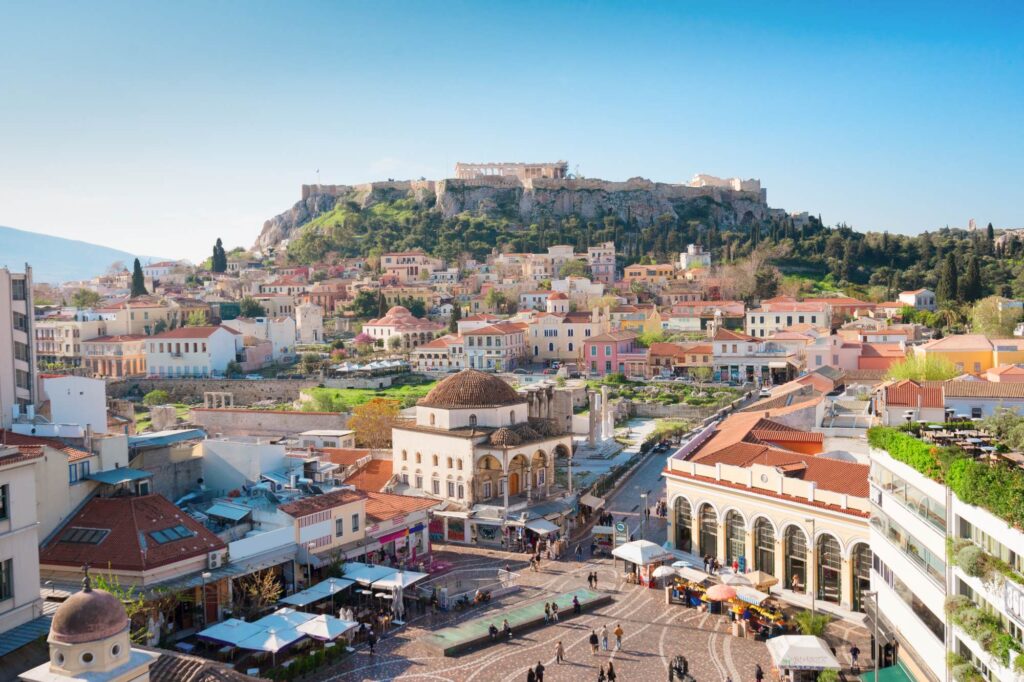
Monastiraki Square and its surrounding neighborhood represent the vibrant, eclectic spirit of Athens, Greece. Located just northwest of Plaka and adjacent to Acropolis Hill, Monastiraki is a bustling hub of activity, offering a rich blend of history, culture, shopping, and dining.
A Central Meeting Place
Monastiraki Square is one of the central places in Athens, known for its lively atmosphere and cultural significance. The square is surrounded by various churches, museums, and historic sites, making it a perfect starting point for exploring the area. Ermou Street, one of Athens' major shopping streets, begins here, offering a wide range of clothing, jewelry, and souvenirs.
Shopping and Dining
Monastiraki is renowned for its vibrant flea market, held every Sunday, where visitors can find an array of antiques, handmade crafts, and unique souvenirs. The neighborhood is also known for its exceptional dining options, where you can enjoy traditional Greek cuisine such as moussaka, souvlaki, and gyros at reasonable prices.
- Ermou Street: This major shopping street offers a variety of shops, from high-end boutiques to local artisan stores, making it a shopper's paradise.
- Flea Market: The Sunday flea market is a must-visit for those looking to find unique items and experience the local culture.
- Dining: Monastiraki is a food lover’s haven, with numerous tavernas, cafes, and street food vendors offering delicious Greek dishes.
Local Vibe and Atmosphere
Monastiraki offers a grittier, more authentic vibe compared to the more touristy Plaka. It’s a place where locals sell their wares on the street, and graffiti and street art are prevalent. This neighborhood is a great representation of the local Athenian lifestyle, with a mix of old and new, tradition and modernity.
Safety and Practical Tips
While Monastiraki is generally safe, some visitors have mentioned feeling slightly uneasy due to the presence of homeless individuals and street vendors. However, by staying aware of your surroundings and keeping personal belongings secure, you can enjoy the area without issues.
- Personal Safety: Keep an eye on your belongings and stay aware of your surroundings, especially in crowded areas.
- Best Time to Visit: Monastiraki is open and free to visit any time of the day. Spending several hours to half a day exploring the shops, markets, and eateries is recommended.
- Accessibility: The neighborhood is easily accessible via the Monastiraki metro station and various bus routes, making it convenient for tourists.
Final Thoughts
Monastiraki is a must-visit neighborhood in Athens, offering a unique blend of historical sites, vibrant markets, and delicious cuisine. Whether you're shopping for souvenirs, enjoying a meal, or simply soaking in the lively atmosphere, Monastiraki provides an authentic Athenian experience that shouldn't be missed.
9. The National Garden of Athens and the Zappeion: An Urban Oasis
The National Gardens of Athens, also known as Zappeion Park, offers a verdant escape right in the heart of the bustling Greek capital. Located near the Hellenic Parliament and several museums, this large park provides a perfect setting for a leisurely stroll or a relaxing break from the city's hustle and bustle.
Historical Background
Originally designed in 1840 by German agronomist Friedrich Schmidt at the behest of Queen Amalia of Oldenburg, the park was initially called the “Royal Gardens.” It was intended to provide a serene retreat for the royal family and the public. The gardens feature a diverse array of plants from around the world, including exotic species that add to the park's unique charm.
Features and Attractions
The National Garden spans a vast area filled with natural beauty and historical remnants. Visitors can explore various objects and ruins scattered throughout the gardens, providing a blend of nature and history. Key attractions include:
- Lush Greenery: The park is home to a wide variety of trees, flowers, and shrubs, offering a picturesque setting for visitors. Tall palm trees and vibrant vegetation provide much-needed shade and a respite from the sun.
- Ponds and Lakes: Several lakes and ponds within the garden add to its tranquil atmosphere. These water features are home to small animals and birds, creating a lively and engaging environment.
- Zoo and Birds: A small zoo within the park houses various animals, while non-endemic birds, such as exotic green parrots, can often be seen flying between the trees.
- Cultural and Recreational Facilities: The garden also features a conservatory, a children's library, and a small cafe. Although the cafe is noted to be somewhat overpriced, it offers a convenient spot for refreshments.
Visiting Information
The National Garden is open to the public from sunrise to sunset, and entry is free of charge. It is considered a safe place for both locals and tourists, with security personnel present throughout the park.
- Accessibility: The park has seven entrances, with the main entrance located on Amalias Avenue, within walking distance of the Syntagma metro station. This makes it easily accessible from various parts of the city.
- Facilities: Public restrooms are available, enhancing the convenience for visitors. The garden is an ideal spot to relax and enjoy nature without straying far from the city center.
Nearby Attractions
The National Garden's proximity to other significant landmarks makes it an excellent addition to any Athens itinerary. After visiting the Acropolis Hill, Plaka, and Anafiotika, travelers can easily transition to the more serene environment of the National Garden. Just a short walk from Syntagma Square, visitors can also admire the Hellenic Parliament, the former Royal Palace, and witness the changing of the guards at the Monument of the Unknown Soldier.
Final Thoughts
The National Garden of Athens is a beautiful, natural retreat that offers a peaceful contrast to the urban environment of central Athens. Whether you're looking to explore the rich botanical diversity, enjoy a leisurely walk, or simply find a quiet place to relax, the National Garden provides a perfect haven for nature lovers and history enthusiasts alike. Add it to your itinerary for a refreshing break during your visit to Athens, Greece.
Anafiotika is a charming and trendy neighborhood in Athens, nestled right beside the historic Plaka district. Known for its car-free, winding streets and picturesque alleys, Anafiotika is characterized by its quaint homes and charming churches. Despite its small size, the area is easy to find due to its prime location just next to Acropolis Hill.
A Romantic Escape
Visitors often describe Anafiotika as one of their favorite parts of Athens. The neighborhood’s beauty and romantic ambiance make it a must-see. Early risers will find the best opportunities to capture stunning photos with the Acropolis towering in the background, unencumbered by crowds.
Exploring Anafiotika
Whether you plan your visit or stumble upon it while exploring Plaka or heading to the Acropolis and Parthenon, Anafiotika offers a delightful escape from the busier parts of the city. You can easily spend several hours here, enjoying a coffee or cocktail at a local café, or shopping at one of the unique boutiques.
Practical Tips
- Free and Accessible: Anafiotika is free to visit and open 24 hours a day, making it a flexible addition to your itinerary.
- Walking and Stairs: The neighborhood is located on a slope under the Acropolis, so be prepared for some climbing and plenty of walking. Comfortable shoes are recommended.
- Photographic Opportunities: For the best photos, visit early in the morning when the light is soft, and the streets are less crowded.
Final Thoughts
Anafiotika is a delightful blend of history, culture, and charm, offering a unique and intimate look at Athens' local life. Its proximity to major landmarks like the Acropolis and Plaka makes it an easy and worthwhile addition to your exploration of the city. Enjoy the serene atmosphere, scenic views, and the quaint beauty of this hidden gem in the heart of Athens.
Travel Tips: Dos and Don'ts for Visitors in Athens
Dos
- Do Visit the Acropolis Early: To avoid the heat and crowds, visit the Acropolis early in the morning. This allows for a more pleasant and less crowded experience.
- Do Wear Comfortable Shoes: Athens is best explored on foot, and the terrain can be uneven, especially around ancient sites. Comfortable walking shoes are a must.
- Do Try Local Cuisine: Enjoy traditional Greek dishes like moussaka, souvlaki, and gyros. Don’t miss trying local desserts such as baklava and loukoumades.
- Do Use Public Transportation: Athens has an efficient public transportation system, including buses, trams, and the metro. It’s a cost-effective way to get around the city.
- Do Be Aware of Pickpockets: In crowded areas like Monastiraki and the metro, keep an eye on your belongings to avoid pickpockets.
- Do Visit Museums and Historical Sites: Take advantage of the wealth of museums and archaeological sites. The Acropolis Museum, National Archaeological Museum, and Benaki Museum are must-sees.
- Do Respect Local Customs: Greeks are known for their hospitality. Be polite and respectful, especially in religious sites like churches and monasteries.
- Do Carry Cash: While many places accept credit cards, small shops and some tavernas may prefer cash. It’s good to have euros on hand for smaller purchases.
Don'ts
- Don’t Ignore Dress Codes: When visiting churches and monasteries, dress modestly. This means no shorts, sleeveless tops, or revealing clothing.
- Don’t Drink Tap Water: While Athens’ tap water is generally safe, it’s better to drink bottled water, especially if you have a sensitive stomach.
- Don’t Rush Through Meals: Greek dining culture is leisurely. Take your time to enjoy meals and the company of others.
- Don’t Forget Sun Protection: The Greek sun can be intense, especially in the summer. Wear sunscreen, a hat, and sunglasses, and stay hydrated.
- Don’t Overlook Less Tourist Areas: While the main attractions are a must, explore lesser-known neighborhoods like Exarchia and Gazi for a more authentic experience.
- Don’t Assume Everyone Speaks English: While many Greeks speak English, especially in tourist areas, learning a few basic Greek phrases can go a long way in showing respect and making connections.
- Don’t Leave Tipping Out: Tipping is appreciated in Greece. A tip of 5-10% is standard in restaurants and cafes.
- Don’t Miss Out on Local Markets: Visit local markets like the Central Market in Athens for fresh produce, meats, and an authentic taste of Greek daily life.
Flights You Need to Athens!
You'll likely need flights to view these awesome places. Click to view our flight search to get search for the best airfares to Athens.
Conclusion
Athens is a safe city where ancient history meets modern vibrancy, offering a wealth of experiences for every visitor. From the iconic Acropolis and its surrounding historic sites to the picturesque neighborhoods of Plaka and Anafiotika, and the serene escape of the National Garden, Athens captivates with its rich cultural heritage and lively atmosphere.
Whether you're delving into the treasures of the National Archaeological Museum, exploring the bustling markets of Monastiraki, or simply enjoying the local cuisine and hospitality, Athens has something to offer everyone. By following the dos and don’ts provided, you can navigate the city with ease, respect the local customs, and fully immerse yourself in the unique charm of the Greek capital.
No matter how many days you spend in Athens, each moment will be filled with discoveries and memories that highlight the city's timeless appeal. Plan your visit thoughtfully, embrace the local culture, and enjoy every step of your journey through this remarkable city.
Top Sights Athens – Frequently Asked Questions
Most Visited and Famous Attractions
The most famous site in Athens is the Acropolis. This ancient citadel, located on a rocky outcrop above the city, contains the remains of several historically significant buildings, including the Parthenon, the Erechtheion, and the Temple of Athena Nike.
The Parthenon, situated on the Acropolis, is the most iconic attraction in Athens. This former temple, dedicated to the goddess Athena, is an enduring symbol of ancient Greek civilization and architectural brilliance.
The Acropolis of Athens is the top tourist destination in Greece. As a UNESCO World Heritage Site, it attracts millions of visitors annually who come to marvel at its historical and architectural significance.
Athens is most known for its rich history and ancient landmarks, particularly the Acropolis and the Parthenon. The city is also recognized as the cradle of Western civilization and the birthplace of democracy, making it a significant cultural and historical center.
Scenic and Picturesque Locations
The most picturesque place in Athens is Anafiotika. Nestled on the slopes of Acropolis Hill, this charming neighborhood is characterized by its narrow, winding streets, whitewashed houses, and vibrant bougainvillea. With its Cycladic island ambiance and stunning views of the Acropolis towering above, Anafiotika offers a perfect setting for picturesque photos and a tranquil escape from the bustling city below.
Planning Your Visit
Yes, you can explore Athens in 3 days. With a well-planned itinerary, you can visit major attractions like the Acropolis, the Acropolis Museum, the Ancient Agora, the National Archaeological Museum, and neighborhoods like Plaka and Monastiraki. This timeframe also allows for some leisurely exploration of the city's cafes, markets, and local cuisine.
Four days is more than sufficient to see Athens. This extra day gives you ample time to visit additional sites such as the Temple of Olympian Zeus, the Panathenaic Stadium, and the Benaki Museum. You can also take day trips to nearby destinations like Cape Sounion or the Temple of Poseidon.
One day in Athens is enough to get a glimpse of the city's highlights, but it will be a very packed schedule. Prioritize visiting the Acropolis, the Acropolis Museum, and a quick stroll through Plaka and Monastiraki. This will give you a taste of Athens' rich history and vibrant culture.
Two days in Athens is adequate for a more relaxed exploration of the city's main attractions. You can cover the Acropolis, the Acropolis Museum, the Ancient Agora, and the National Archaeological Museum, as well as enjoy some time wandering through Plaka, Monastiraki, and other central neighborhoods.
To fully appreciate Athens, a stay of 3 to 4 days is ideal. This duration allows you to see all the major historical sites, explore different neighborhoods, enjoy local cuisine, and even take short excursions to nearby attractions. It provides a well-rounded experience of both ancient and modern Athens.


